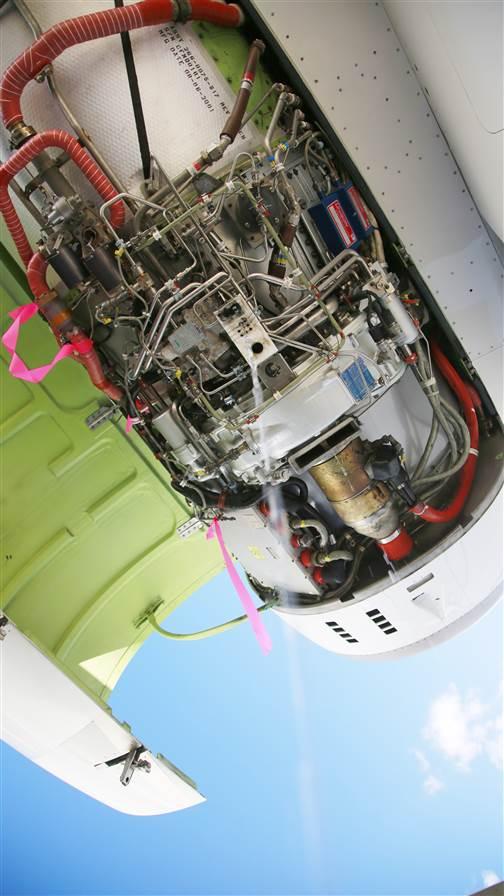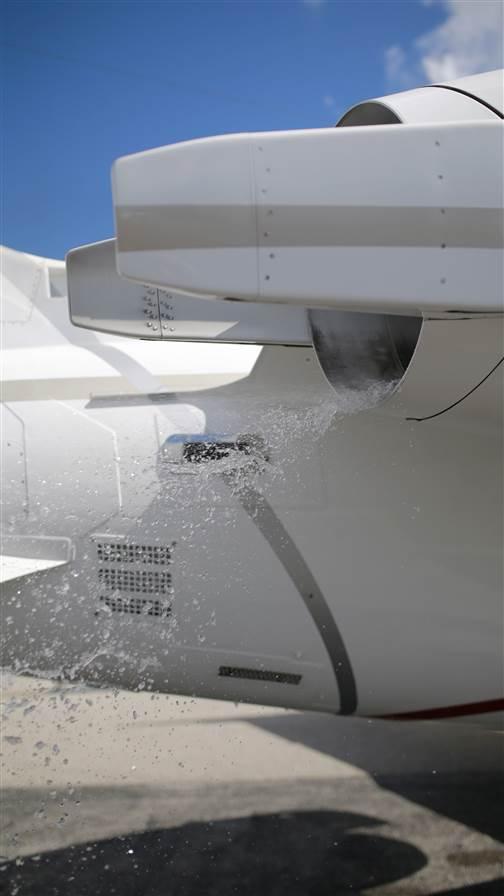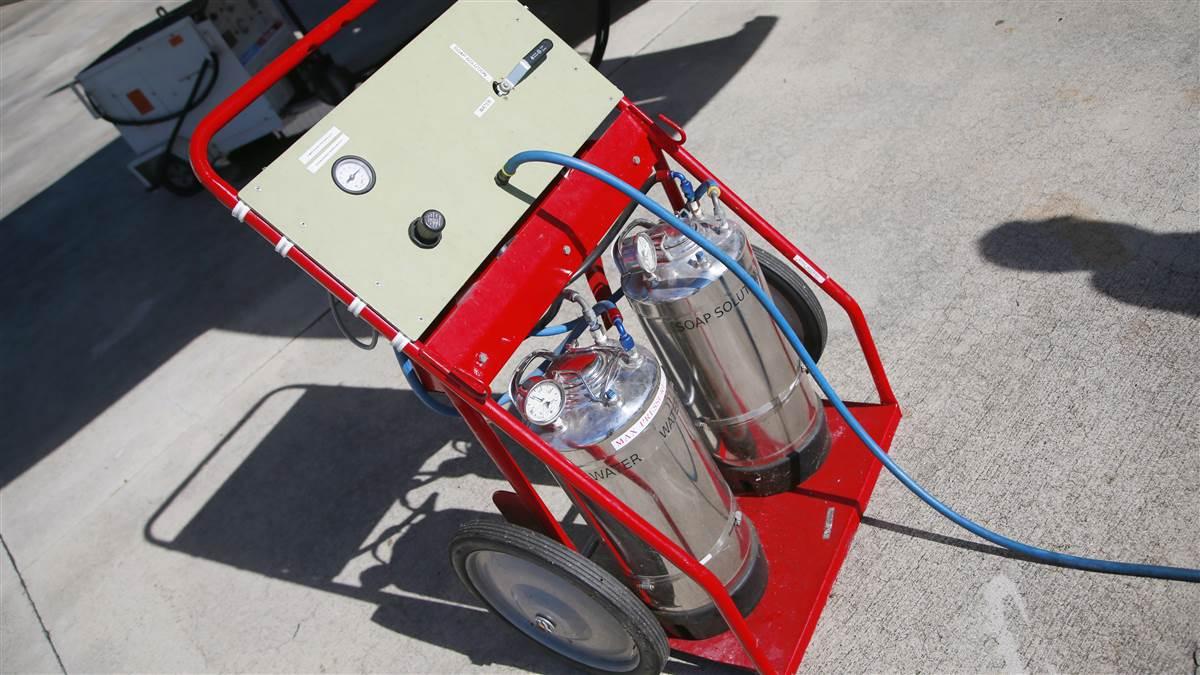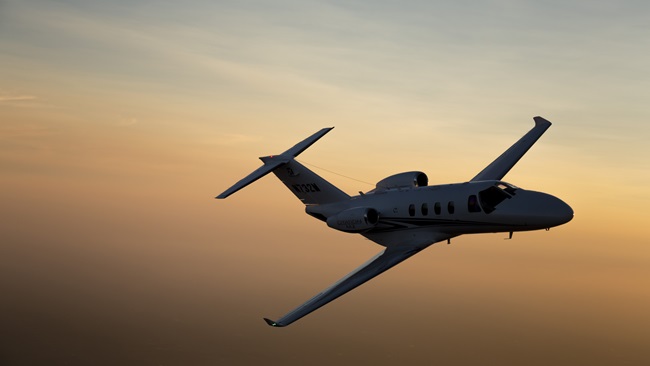Clean Cores
How compressor washes and rinses restore power and fight corrosion

 There isn’t the wear-inducing clatter of a mass of pistons, connecting rods, wrist pins, and valve assemblies that you have in piston-powered engines. Instead, air enters intakes, is compressed by a stack of smoothly spinning compressor wheels, gets ignited in a combustion chamber free of moving parts, and moves on to sets of power turbine wheels that either drive reduction gearboxes (in turboprops) or generate thrust (in turbofan-powered aircraft). You’ve heard the nickname for this process: suck (intake), squeeze (compression), bang (combustion), blow (exhaust, or thrust).
There isn’t the wear-inducing clatter of a mass of pistons, connecting rods, wrist pins, and valve assemblies that you have in piston-powered engines. Instead, air enters intakes, is compressed by a stack of smoothly spinning compressor wheels, gets ignited in a combustion chamber free of moving parts, and moves on to sets of power turbine wheels that either drive reduction gearboxes (in turboprops) or generate thrust (in turbofan-powered aircraft). You’ve heard the nickname for this process: suck (intake), squeeze (compression), bang (combustion), blow (exhaust, or thrust).
While this comparative simplicity confers reliability on turbine powerplants, there is, of course, no free ride. Turbine engine manufacturers require routine maintenance and inspections at designated intervals. Two procedures in particular are aimed at keeping the internal components clean.
Regular compressor washes remove dirt and baked-on combustion byproducts that accumulate on compressor and turbine wheels. These washes are especially important with turbofan and turbojet engines because air flows unimpeded in its path through the engine sections. Most turboprop engines, with their inertial separators and debris screens, are less prone to ingesting dirt. However, compressor-wash and other maintenance recommendations vary from engine to engine, so check with your shop and your engine’s maintenance manual for specific guidance and procedures.
Again, procedures vary, but compressor washes follow the same general steps. First, let the engine cool for a specified time, and cap off any probes, valves, or vents. Next—with turbofans—is to prevent the fan from moving by locking it with wedges or a wash nozzle manifold assembly. Then a mildly caustic alkaline solution is forced into the engine at a specified rate, say, 25 gph, or at a specified pressure, say, 50 psi. This can be done using a wash “wand” or the manifold. All the while, a technician is in the cockpit, motoring the engine core (engaging the starter to turn the engine, but not start it). After 30 seconds or so, the wash is complete, and then distilled water is sent through the engine to rinse the detergent solution from the internal components. The effluent—a black slurry of water and gunk—runs out a drain port and onto the ground. Then it’s time for a runup to dry the engine, and the job’s done. Cost? For light jets, about $750 for two engines.

As for turboprop engines, many come with built-in wash ports that connect to an internal wash ring. This obviates the need for an external wash manifold or wash wand. By the way, turboprop engine compressor washes may not be needed as often. Technicians have mentioned that Pratt & Whitney’s PT6 series of engines seem to have compressor sections that resist buildups. And one technician said that he’s never had to do a compressor wash on a Garrett/Honeywell TPE-331 engine.
Another type of engine cleaning may be less familiar to some pilots. This is the desalination rinse, and anyone who flies near oceans should take notice. Desalination rinses involve shooting distilled water into a motoring engine, much the same as a compressor wash. But here the goal is to prevent corrosion by ridding the compressor of salt deposits.
And where exactly can you expect salt deposits? Pratt & Whitney says that the more often an airplane is operated in a salt-laden environment, the more frequent desalination washes should be done. What counts as a salt-laden environment? Pratt & Whitney says a takeoff or landing in an area not more than 10 nautical miles from the sea counts, as does a flight route that’s not more than 10 nautical miles from, or will be over, the sea and at an altitude of less than 10,000 feet.
There’s more. Flying in the presence of salt haze, “created by finely divided particles of sea salt in the air, usually derived from the evaporation of sea spray” calls for further measurement in terms of exposure times. Daily exposure to salt haze is defined as “continually” operating in a salt-laden environment; flying once every one to two weeks amounts to “frequent” operations; and irregularly flying in salt-laden air is dubbed “occasional” operations. The definitions are further split by severe, moderate, and mild salt-laden environments. It all boils down to recommended desalination washes at intervals anywhere from three to 12 months, depending on the engine and the manufacturer. At about $650 per wash for light jets.
 Information from engine trend monitoring can be used to alert owners, pilots, and maintenance personnel of the need for compressor washes. Cockpit indications such as higher than typical interstage turbine temperatures (ITTs) can also signal the presence of buildups. After a wash, engines should run cooler, and even regain some lost power.
Information from engine trend monitoring can be used to alert owners, pilots, and maintenance personnel of the need for compressor washes. Cockpit indications such as higher than typical interstage turbine temperatures (ITTs) can also signal the presence of buildups. After a wash, engines should run cooler, and even regain some lost power.
As for flying in salt-laden environments, or in salt haze, it’s up to the owner or pilot to decide if a desalination rinse is in order. It may sound like overkill, but one Pratt & Whitney maintenance document says that if an engine is exposed to a salt-laden environment, the engine must have a desalination wash at the first available opportunity after the engine is removed from that environment. For those flying from one coastal airport to another, that would mean a desalination rinse at each stop! On the other hand, if a borescope exam shows any corrosion you may have to kiss any warranty coverage goodbye.
Email [email protected]



